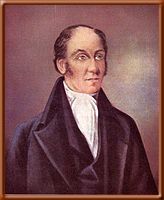Timothy Hackworth
| Timothy Hackworth | |
|---|---|
 |
|
| Born | 22 December 1786 Wylam |
| Died | 7 July 1850 (aged 63) |
| Nationality | English |
| Engineering career | |
| Discipline | Locomotive engineer |
Timothy Hackworth (22 December 1786 – 7 July 1850) was a steam locomotive engineer who lived in Shildon, County Durham, England and was the first locomotive superintendent of the .
Born in Wylam in 1786, Timothy Hackworth was the eldest son of John Hackworth who occupied the position of foreman blacksmith at Wylam Colliery until his death in 1804; the father had already acquired a considerable reputation as a mechanical worker and boiler maker. At the end of his apprenticeship in 1807 Timothy took over his father's position. Since 1804, the mine owner, Christopher Blackett had been investigating the possibilities of working the mine's short 5-mile (8.0 km) colliery tramroad by steam traction. Blackett set up a four-man working group including himself, William Hedley, the viewer; Timothy Hackworth, the new foreman smith and Jonathan Foster, a "wright". The first step in 1808 was the relaying of the Wylam tramway with cast iron plates, until then a simple timber-way. In 1811, the four-man team began investigating the adhesive properties of smooth wheels using a manually operated carriage propelled by a maximum of four men, and in the same year a single-cylinder locomotive devised by one Waters, reportedly on the Trevithick model, was built and tried for a few months with erratic results.
In the meantime a new dilly, (the term used to designate all locomotives at Wylam), was put in hand and set to work in the Autumn of 1812. However even Blackett's new cast iron plateway was found inadequate to sustain the weight of a dilly and the subsequent one built in 1813 was carried on two four-wheeled "power bogies" and it is understood that the first one was similarly rebuilt. On the relaying, around 1830, of the Wylam line with wrought iron edge rails, the two locomotives were reverted to the 4-wheel arrangement, continuing to work until the closing of the line in 1862. What is considered to be the earlier of the two engines, now known as Puffing Billy is conserved at the Science Museum in London; the second Wylam Dilly is in the Royal Scottish Museum in Edinburgh.
Although William Hedley is generally credited with the "design" of the locomotives, there is strong evidence that these issued from the aforementioned joint collaboration in which Christopher Blackett was the driving force with Timothy Hackworth playing a preponderant engineering role. Furthermore, it subsequently fell to Hackworth to maintain the locomotives in running order and improve performance. As time went on, Blackett became increasingly occupied by other outside interests and was often absent, leaving Hedley in charge of the mine; Hackworth found himself in conflictual situations due his Methodist activities and his refusal to work on the Sabbath, until he felt obliged to leave Wylam in 1816.
...
Wikipedia
